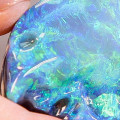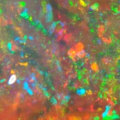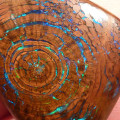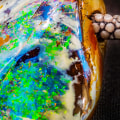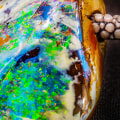Most genuine solid opals have an irregularity in this area (curved or bumpy due to their natural formation), whereas an artificial stone will be perfectly flat because the two sections are flattened so that they can stick together. Take special care if the opal is set in jewelry and you can't see its back or side. Check if the opal is transparent or if it has a white body tone. If you do, you can be pretty sure it's a genuine solid opal.
Probably a white opal or a crystal opal. If you have a dark body, there is a possibility that it is a doublet or a triplet, since they have an artificial black backing that causes a dark body tone. To identify real opal, view it from the side. It is not composed of different layers; it has no column structure or lizard skin effect on the surface.
Real opal is made of silica, not glass, plastic, or resins. Real opal is very homogeneous from different sides. First, check if the opal has a black or white lining or backing. If it does, then the mineral combination is man-made, and depending on how many colors you have, you may be holding a doublet or a triplet.
The doublet or triplets aren't necessarily fake, but you don't have pure opal. However, synthetic opals can be considered imitations, since they contain additional materials (such as different types of plastic) that are not present in natural opals. If the description doesn't indicate where it came from, not only is it incomplete, but it's probably an indication of a fake opal. If you look at an opal from the side and the pattern seems to suddenly become linear, this is not natural and it is likely that a laboratory has been created.
We will put assembled or composite stones on the counterfeit list because these types of opal are usually sold already embedded in the piece of jewelry, and sellers prefer not to reveal the truth. Eagerly waiting for the loading screen to mark your purchase, you wonder if the opal you are about to buy could be fake considering the number of fakes out there. These are not completely fake opals, but rather a combination of both synthetic materials of real opal & to give the impression that it is solid opal. The presence of any additional contents adhering to the opal main body indicates considerable modification by the manufacturer.
There are also other methods to find out if your opal is real or not, however, they would involve seeking professional help. Mexican fire opal has a bright red, orange, or yellow background, mostly transparent or translucent. A genuine opal stone dealer is also likely to be a member of a gemological association or jewelers. Triplets have a transparent third layer, in addition to the second non-opal layer, doublets have; in essence, triplets consist of a real opal sandwiched between a darker back and a transparent top layer.
Most of them don't have precious iridescence, but still, these warm colors of natural red Mexican opals are highly praised. Since synthetic opals don't actually contain any of the precious opal compounds, they are substantially lower in price than their natural counterparts. In the 1970s, Gilson Company developed a three-step process, usually repeating the natural environment, to produce convincing synthetic opal. The best way to identify true Australian opal is to ask the direct location where the opal was extracted.
Slocum stone is a silicate glass with fine translucent iridescent film flakes, which produce a play of color similar to opal.


